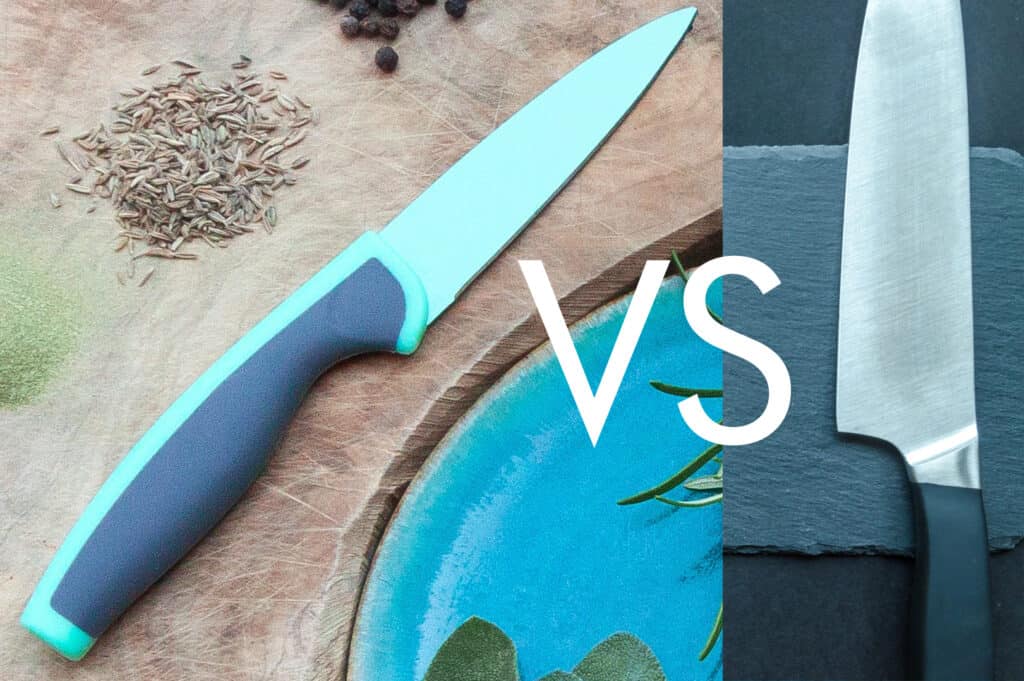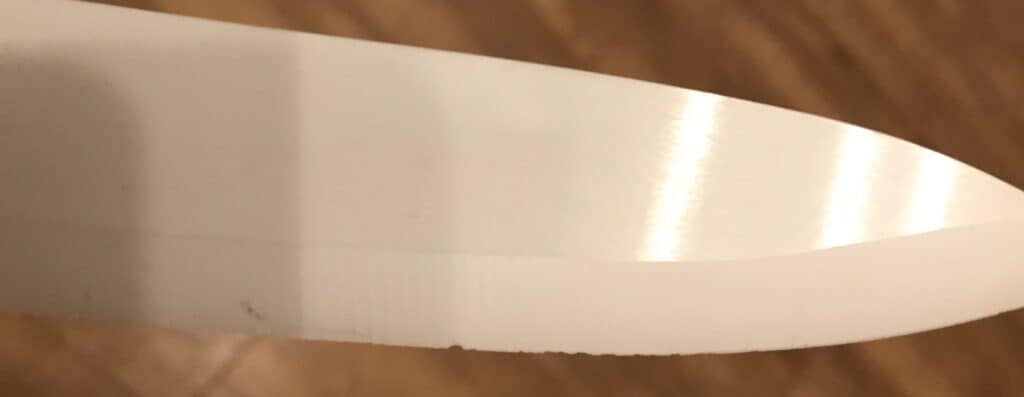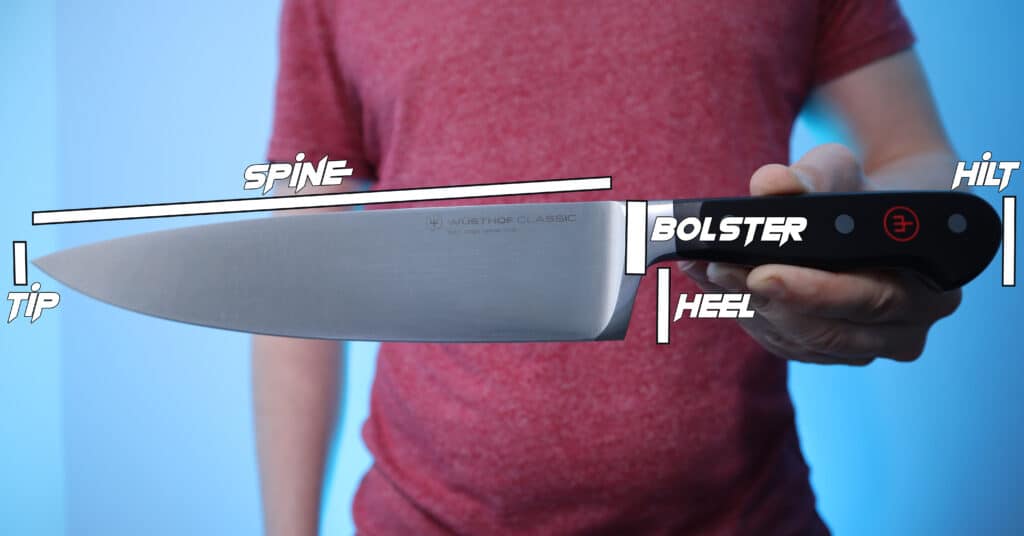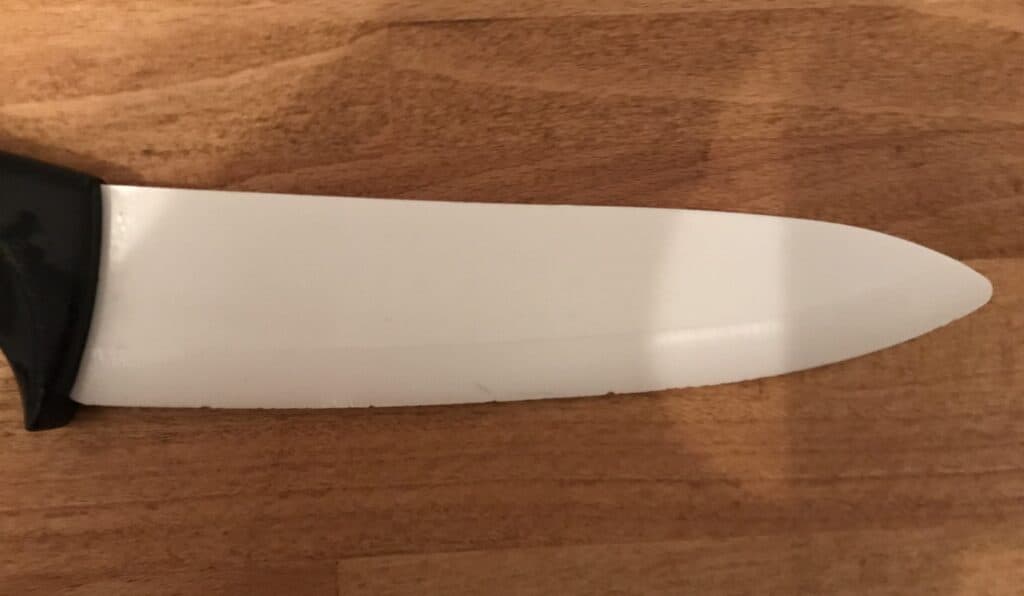
Ceramic knives can be a bit of a mystery. I still remember when I first saw one, it seemed pretty strange to have a knife made from ceramic, isn’t that what flower posts are made from? It sounds like the type of knife they would have used in 4000 BC, before the invention of iron forging.
But like I often am, I was wrong. Ceramic does actually have some tremendous qualities which make it a very useful material for knife blades. There are, and will always be, those who disregard ceramic knives as a gimmick, but they do have their purpose.
Ceramic knives certainly aren’t going to overtake the popularity of steel knives but they do have their benefits.
In this article, I want to discuss the pros and cons of ceramic knives against their steel counterparts. We’re going to directly compare the two materials to understand when a ceramic knife can outperform a steel knife, and when it can’t.
If you search online there are a ton of articles saying ceramic knives are no good on sites like www.we-sell-steel-knives.com, likewise www.ceramic-for-life.com will marvel in awe over the ceramic revolution.
I like to think I don’t have quite the same bias agenda as these reviews, so this is going to be an honest portrayal of the respective advantages and disadvantages of ceramic vs steel knives for the kitchen.
If you’re interested in purchasing a quality steel or ceramic knife then I have in-depth reviews of both in these two articles below.
| My Steel Knife Recommendations | My Ceramic Knife Recommendations |
| View the list here | View the list here |
Pros and cons of ceramic and steel knives
I’m going to look at five important topics. I think these five topics are a pretty good set of judging any knife.
For those in a rush here are my overall scores for ceramic vs steel knives in each topic. For a more in-depth look into each one, and an overall summary then read on!
| Category | Ceramic | Steel |
| Sharpness | 9 | 7 |
| Durability | 4 | 8 |
| Ease of maintenance | 7 | 7 |
| Weight | 9 | 6 |
| Price | 6 | 8 |
| Total | 35 | 36 |
One important thing for any knife enthusiasts to note here. I’m going to be talking about western style steel kitchen knives rather than any other type such as Japanese style knives. These are the ones most people have in their kitchen so it’s the fairest comparison.
Sharpness
Sharpness is a pretty important category for knives. It’s essentially the entire point of the after all so this is going to be a big one to win!
For things to be sharp, they generally need to be hard. The softer a material is then the quicker it will go blunt. So when we are talking knives, we want to use as sharp a material as practically possible.
This is good news for ceramic knives. Ceramic is extremely hard, I know it’s difficult to believe when you’re thinking of the ceramic used to make flower pots, but ceramic knives are amongst the hardest knives you’ll be able to buy.
In fact, ceramic is so hard that the material is used in sharpening devices to sharpen steel blades. I actually think it’s the best material to use for steel knife sharpening, it’s just hard enough to remove a layer of steel from the blade, without being too destructive like diamond-encrusted sharpening tools can be.
Because ceramic is such a hard material, ceramic knives often come straight out of the factory with a sharper edge than their steel counterparts. They also have much better retention of the sharp edge than a steel blade does.
Steel blades should be honed using a honing rod at least every three uses to maintain a sharp aligned edge. Ceramic knives don’t need to be honed at all.
However, ceramic knife salesmen will tell you that ceramic knives never need to be sharpened. This is not true, they will go blunt eventually. We’ll discuss sharpening in the ease of maintenance category but for now, ceramic knives win the sharpness category hands down.
Ceramic – 9/10
Steel – 7/10
Durability
This is another important consideration and it’s one where the lines do get blurred a little bit.
Ceramic is very hard, no doubt about that, but it’s also very brittle. Imagine a sheet of marble and a sheet of foam. Clearly the marble is harder, but if you deliver a short, hard impact the marble is more likely to break. Drop them both on the floor and the foam won’t snap in half but the marble probably will.
It’s the exact same with ceramic and steel. Steel is somewhat flexible. If you drop a steel blade there’s no chance it will break, in fact, you have to be pretty brutal to a steel blade to even chip the thin edge of the blade.
This isn’t the case with ceramic. If you drop a ceramic blade it may indeed crack. But that’s fine right, we don’t tend to go around dropping knives all over the place, after all, there’s more danger to that than the knife chipping! So what’s the problem?
The problem is bones, and there can be a lot of them when cooking. You shouldn’t really use a ceramic knife for cutting anything which may contain a hard section. This mainly relates to hard bones in meat and some larger fish. You should use a ceramic knife to cut a chicken for example, unless it’s a boneless chicken breast.
But it also translates to any food with a hard section, think of avocados for example, the hard stone could easily chip the blade of a ceramic knife.
Here’s a photo of one of my own ceramic knives which just hasn’t been looked after at all. The whole edge is chipped and it really needs to be sharpened to be made right again.

I’m not proud of this!
So that’s the issue with ceramic knives. Used in the correct way, cutting only soft food they are very durable and it will take them a long time to go blunt.
But use them on the wrong food, or store them somewhere they might get knocked around such as a drawer then they can get very easily chipped and damaged, so steel knives win this one.
Ceramic – 4/10
Steel – 8/10
Ease of maintenance
This is an interesting one.
Let’s start with steel knives. To properly maintain a steel knife you will need to hone it and sharpen it. Honing can be done using a honing rod and I’d advise honing your knives after every three uses.
It’s pretty simple and it only takes a few seconds per knife but it’s crucial that you do this if you want your steel knife to last as long as possible between sharpening. With sharpening, you can either use your own sharpening tools or you can send your knife off to an expert who will sharpen it for you. You’ll only need to do this every year or two and your knives will remain razor-sharp.
The advantage of ceramic knives is that you don’t need to hone them at all. So if you take care not to chip the brittle knife-edge then the knife will stay sharp for a very long time without the need for any maintenance.
When it comes to sharpening a ceramic knife you are more limited. Ceramic is so strong that you’ll only be able to sharpen it effectively using diamond encrusted tools. There are a host to choose from, diamond sharpening rods, diamond electric sharpeners, diamond pull through sharpeners and even diamond whetstones.
Alternatively, since they need to be sharpened so infrequently, if you have a set of ceramic knives it would make a lot of sense to send them off to be sharpened by a professional every five years or so. For the cost, it is probably worth it.
So, steel knives need constant honing but ceramic knives are harder to sharpen. On this one, I’m calling it a draw.
Ceramic – 7/10
Steel – 7/10
Weight
Steel knives can be bulky and heavy. Western-style steel knives are especially heavy, this is due to a couple of factors. Firstly the blade is relatively thick because the angle of the blade edge has to be quite large to retain its strength, for a comparison, Japanese knives have an edge angle of around 13 degrees whereas a western-style knife is typically 20 degrees. So a thicker blade means more steel and therefore more weight.
Additionally, western steel blades have a chunky bolster, that’s the thick piece of steel that connects the blade with the handle.
Due to those two factors, the western style steel knives we are all used to are some of the heaviest knives you can buy.
Ceramic, on the other hand, is a very light material to begin with. This means that a ceramic knife will pretty much always be lighter than a steel counterpart.
A lighter knife has the advantage of being easier to handle and use, it also helps with long cooking sessions and preparation of vegetables such as onions and potatoes which can be quite labor intensive.
Ceramic knives gain a convincing and unarguable win in the weight category.
Ceramic – 9/10
Steel – 6/10
Price
Ceramic knives are generally thought of as pretty expensive. I think this can sometimes be a little misleading.
Individual ceramic knives can be expensive, and replacing your whole set of knives with ceramic ones certainly will be expensive, but I don’t think they are actually too expensive as individual items.
In my opinion, you have to look at the quality of the knife, how much you’ll use it and then asses the price.
I always recommend spending the most money on your chef’s knife, this is the main all-rounder knife of the kitchen and it’s the ones you’ll probably use the most, so spending $50 + on a quality steel chef’s knife is totally sensible, and since it’ll last for decades with proper maintenance then it really isn’t that expensive, even if you go for a top range one above $150.
For me, you should apply the same concept to a ceramic knife. You can buy ceramic knife sets and honestly I wouldn’t really recommend this. Many of them have a range of three slightly different sizes of paring knives, which is a little pointless, you will only end up using one.
I would recommend that you go for one high quality 5 – 7 inch ceramic knife. That’ll make it a bit bigger than a paring knife but a bit smaller than a chef’s knife and ideal for cutting fruit and vegetables.
You’ll be able to get a good quality ceramic knife of that size for between $30 – $50, and a really top-end one for less than $100. So compared to a quality steel knife I think it’s pretty much the same.
BUT, to be fair, if you were trying to create a whole ceramic knife set then it would get pretty pricey. There isn’t any point buying super cheap ceramic knives because they will just be low quality and go blunt easily which defeats the purpose of them. Whereas you can go out and buy inexpensive sets of steel knives which will still last a long time if maintained properly.
So this round does go to steel knives because you can get a set of decent steel knives for a good price. But if you’re just looking to get one quality ceramic knife for your kitchen I really don’t think there is much difference in price.
Ceramic – 6/10
Steel – 8/10
Summary
So steel knives win, just! They get a one-point advantage on ceramic ones.
One category in particular does stand out, and it’s the one which causes the most complaints about ceramic knives; durability.
They do chip very easily, which can make them a bit of a pain to use and difficult to store.
However; I think this has actually been amplified by the marketing men trying to sell ceramic knives. We are told they are harder than steel, without being told about how brittle they are, so I think people use them expecting them to be unbreakable.
If you use a ceramic knife the way it should be used, cutting only soft food, nothing with a hard interior such as bones and stones then they can be a fantastic tool, worthy of its place in any home kitchen.

